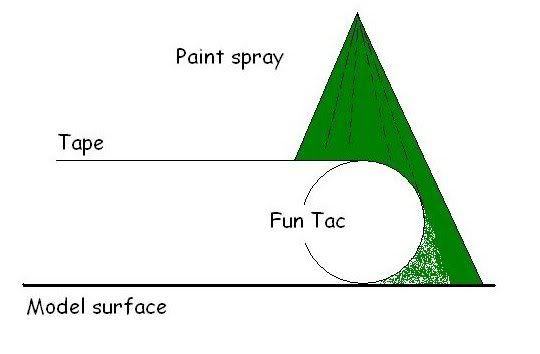HI everyone,
I am doing a collection of aircraft from the Vietnam War. I have a Huey Helo, an F4 Phantom, and a Mig 17.
My question is how do you airbrush the Camo on the Phantom and the Huey, without getting the over spray on the other colors? The Mig is going to be unpainted (all Aluminum). When i painted them with a brush, it had a very destinctive line at the colors border. I want it to look feathered if this is the right word.
Thanks,
Ken
Ken, the feathered edge can be free hand airbrushed but it does take a bit of practice to get the fine edge. The "Nam camo had had fine feathered edge and I think the poster tack method would to well for it.
!st paint the base color. Roll some poster tack to a thin rope and follow the camo line with it and fill in with tape. Spray the second color and just a little gets under the rounded edge of the poster tack. Keep the airbrush perpendicular to the model.

!(http://wingnutmodels.com/images/Spitfire MkV_build (5).JPG)
!(http://wingnutmodels.com/images/Spitfire MkV_build (6).JPG)
!(http://wingnutmodels.com/images/Spitfire MkV_build (8).JPG)
Actually you do as the camo used on US aircraft has a soft or blended edge…that is they overlap each other.
Technique…you can free hand these patterns using an airbrush or you can use masking…here is one method:
Paper Towel Masking

Any kind of airbrushing takes a lot of practice, and camouflage takes even more. But it can be done, and looks great if done right. You just need to take great care. You need to crank spray down to a fine line. Thus, a double action brush may be better for freehand camouflage, but it can be done with SA with lots of practice.
Thanks Everyone,
Great ideas [blns]:
I thought I was going to have to paint it with a brush like I did when I was a kid. [8-|]
Freehanding isn’t bad if you want soft edged camo. And you can always touch it up. Have an image of the pattern you want to do and draw it in lightly on the model with a pencil. Then start spraying. And if you color outside the lines you can fix it. Work with low air pressure and thin paints. I use a pad of watercolor paper or a sheet of styrene to practice on. You could use a milk jug or old model.
Outside of learning to control the overspray the biggest problem to me is holding the model in one hand, airbrush in the other and trying to follow the lines. I can do it but it’s easier with support. So, I bought a cheap easle at WalMart (about $7) and lay my watercolor pad on it and the model on top. I can set down at a table, adjust the angle up or down and use both hands to steady the airbrush. Not too hard to wrap around the sides of what you’re painting. But that’s just me. You can prop it up any number of ways if you need to.
Tony

